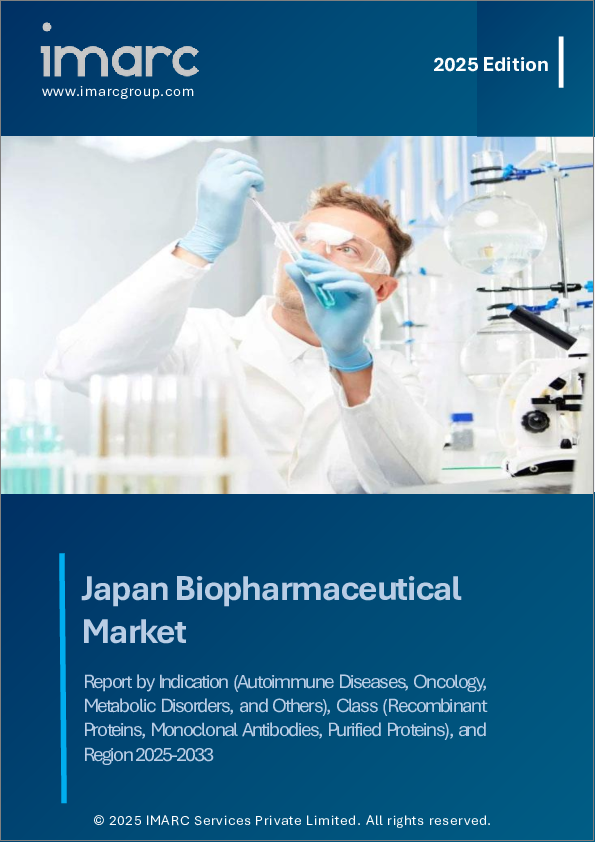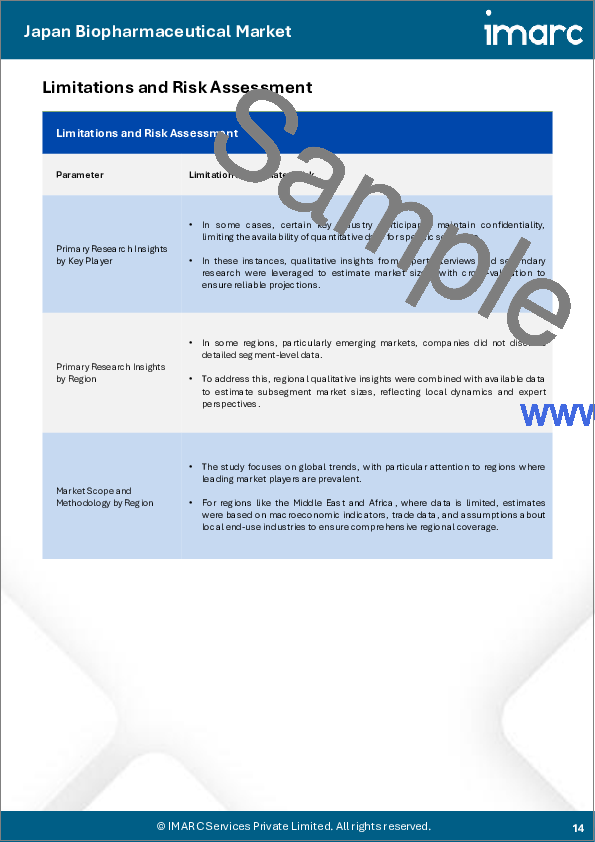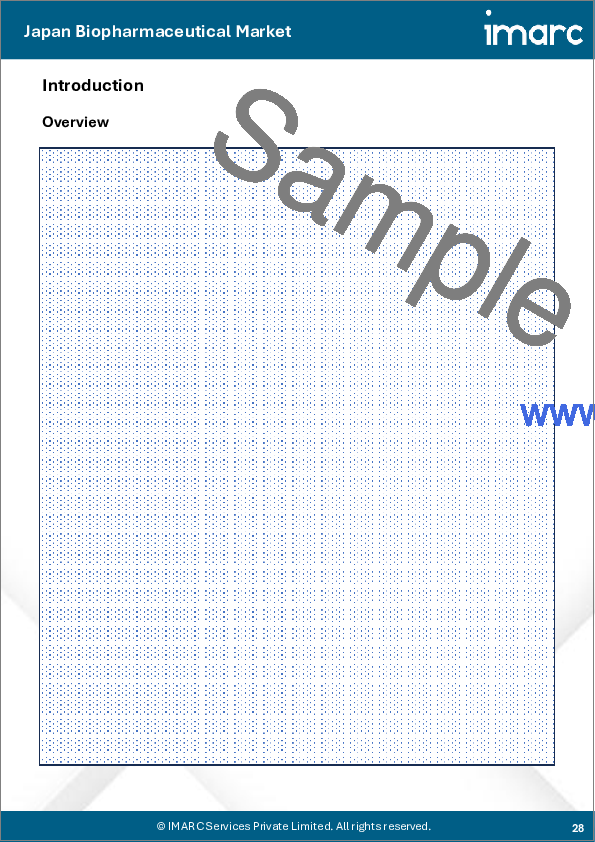|
|
市場調査レポート
商品コード
1747034
日本のバイオ医薬品市場レポート:適応症別、クラス別、地域別、2025~2033年Japan Biopharmaceutical Market Report by Indication (Autoimmune Diseases, Oncology, Metabolic Disorders, and Others), Class (Recombinant Proteins, Monoclonal Antibodies, Purified Proteins), and Region 2025-2033 |
||||||
カスタマイズ可能
|
|||||||
| 日本のバイオ医薬品市場レポート:適応症別、クラス別、地域別、2025~2033年 |
|
出版日: 2025年06月02日
発行: IMARC
ページ情報: 英文 120 Pages
納期: 5~7営業日
|
全表示
- 概要
- 目次
日本のバイオ医薬品市場規模は2024年に235億米ドルに達しました。今後、IMARC Groupは、2033年までに同市場が358億米ドルに達し、2025~2033年の成長率(CAGR)は4.56%に達すると予測しています。同市場は、オーダーメイド医薬品へのニーズの高まり、慢性疾患や生活習慣病の罹患率の上昇、バイオテクノロジー、特に遺伝子工学や組み換えDNA技術などの分野における急速な進歩など、いくつかの主要な要因により成長を遂げています。
本レポートで扱う主な質問
- 日本のバイオ医薬品市場はこれまでどのように推移し、今後どのように推移するのか?
- COVID-19が日本のバイオ医薬品市場に与えた影響は?
- 日本のバイオ医薬品市場の適応症別区分は?
- 日本のバイオ医薬品市場のクラス別区分は?
- 日本のバイオ医薬品市場のバリューチェーンにおける様々なステージとは?
- 日本のバイオ医薬品の主要な促進要因と課題は?
- 日本のバイオ医薬品市場の構造と主要プレーヤーは?
- 日本のバイオ医薬品市場における競合の程度は?
目次
第1章 序文
第2章 調査範囲と調査手法
- 調査の目的
- ステークホルダー
- データソース
- 市場推定
- 調査手法
第3章 エグゼクティブサマリー
第4章 日本のバイオ医薬品市場 - イントロダクション
- 概要
- 市場力学
- 業界動向
- 競合情報
第5章 日本のバイオ医薬品市場情勢
- 過去および現在の市場動向(2019~2024年)
- 市場予測(2025~2033年)
第6章 日本のバイオ医薬品市場 - 症状別内訳
- 自己免疫疾患
- 腫瘍学
- 代謝障害
- その他
第7章 日本のバイオ医薬品市場 - クラス別内訳
- 組み換えタンパク質
- モノクローナル抗体
- 精製タンパク質
第8章 日本のバイオ医薬品市場 - 競合情勢
- 概要
- 市場構造
- 市場企業のポジショニング
- 主要成功戦略
- 競合ダッシュボード
- 企業評価象限
第9章 主要企業のプロファイル
第10章 日本のバイオ医薬品市場 - 業界分析
- 促進要因・抑制要因・機会
- ポーターのファイブフォース分析
- バリューチェーン分析
第11章 付録
Japan biopharmaceutical market size reached USD 23.5 Billion in 2024. Looking forward, IMARC Group expects the market to reach USD 35.8 Billion by 2033, exhibiting a growth rate (CAGR) of 4.56% during 2025-2033. The market is experiencing growth due to several key factors, including an increasing need for customized medicines, the rising incidence of chronic and lifestyle-related illnesses, and rapid advancements in biotechnology, particularly in areas like genetic engineering and recombinant DNA technology.
Biopharmaceuticals, also referred to as biologics, belong to a category of pharmaceutical medications that originate from biological sources. These drugs are manufactured through biotechnological processes utilizing living organisms such as bacteria, yeast, or mammalian cells. In contrast to conventional small-molecule drugs synthesized chemically, biopharmaceuticals are characterized by their large and intricate molecular structures, which allow them to engage in highly precise interactions with biological targets within the body. Biopharmaceuticals offer numerous advantages over traditional pharmaceuticals. They often demonstrate a remarkable degree of specificity in their action, frequently targeting particular receptors or molecules. This specificity typically leads to enhanced effectiveness and a reduction in adverse side effects. Moreover, biopharmaceuticals hold the potential to treat diseases that were historically challenging to address using conventional drug approaches.
Japan Biopharmaceutical Market Trends:
In Japan, several factors are contributing to substantial market growth. Firstly, there is a notable surge in demand for personalized medicine, which is a significant driver. Additionally, the increased adoption of biopharmaceuticals for treating conditions such as cancer, diabetes, psoriasis, and rheumatoid arthritis is another key factor fueling this growth. Furthermore, there is a growing awareness among the general population regarding the effectiveness and accessibility of biopharmaceuticals, further propelling the regional market. Moreover, there is a heightened focus on addressing rare diseases and developing orphan drugs, which is driving market growth. These rare diseases, often characterized by small patient populations, present significant unmet medical needs. Besides this, governments and regulatory agencies have introduced incentives and streamlined regulatory processes to encourage the development of therapies for these conditions, which is acting as another significant growth-inducing factor. Furthermore, biopharmaceutical companies are actively investing in research and development (R&D) efforts to create orphan drugs targeting rare diseases. This approach not only addresses critical medical needs but also creates opportunities for expanding the market over the forecasted period.
Japan Biopharmaceutical Market Segmentation:
Indication Insights:
- Autoimmune Diseases
- Oncology
- Metabolic Disorders
- Others
Class Insights:
- Recombinant Proteins
- Monoclonal Antibodies
- Purified Proteins
Competitive Landscape:
The market research report has also provided a comprehensive analysis of the competitive landscape. Competitive analysis such as market structure, key player positioning, top winning strategies, competitive dashboard, and company evaluation quadrant has been covered in the report. Also, detailed profiles of all major companies have been provided.
Key Questions Answered in This Report:
- How has the Japan biopharmaceutical market performed so far and how will it perform in the coming years?
- What has been the impact of COVID-19 on the Japan biopharmaceutical market?
- What is the breakup of the Japan biopharmaceutical market on the basis of indication?
- What is the breakup of the Japan biopharmaceutical market on the basis of class?
- What are the various stages in the value chain of the Japan biopharmaceutical market?
- What are the key driving factors and challenges in the Japan biopharmaceutical?
- What is the structure of the Japan biopharmaceutical market and who are the key players?
- What is the degree of competition in the Japan biopharmaceutical market?
Table of Contents
1 Preface
2 Scope and Methodology
- 2.1 Objectives of the Study
- 2.2 Stakeholders
- 2.3 Data Sources
- 2.3.1 Primary Sources
- 2.3.2 Secondary Sources
- 2.4 Market Estimation
- 2.4.1 Bottom-Up Approach
- 2.4.2 Top-Down Approach
- 2.5 Forecasting Methodology
3 Executive Summary
4 Japan Biopharmaceutical Market - Introduction
- 4.1 Overview
- 4.2 Market Dynamics
- 4.3 Industry Trends
- 4.4 Competitive Intelligence
5 Japan Biopharmaceutical Market Landscape
- 5.1 Historical and Current Market Trends (2019-2024)
- 5.2 Market Forecast (2025-2033)
6 Japan Biopharmaceutical Market - Breakup by Indication
- 6.1 Autoimmune Diseases
- 6.1.1 Overview
- 6.1.2 Historical and Current Market Trends (2019-2024)
- 6.1.3 Market Forecast (2025-2033)
- 6.2 Oncology
- 6.2.1 Overview
- 6.2.2 Historical and Current Market Trends (2019-2024)
- 6.2.3 Market Forecast (2025-2033)
- 6.3 Metabolic Disorders
- 6.3.1 Overview
- 6.3.2 Historical and Current Market Trends (2019-2024)
- 6.3.3 Market Forecast (2025-2033)
- 6.4 Others
- 6.4.1 Historical and Current Market Trends (2019-2024)
- 6.4.2 Market Forecast (2025-2033)
7 Japan Biopharmaceutical Market - Breakup by Class
- 7.1 Recombinant Proteins
- 7.1.1 Overview
- 7.1.2 Historical and Current Market Trends (2019-2024)
- 7.1.3 Market Forecast (2025-2033)
- 7.2 Monoclonal Antibodies
- 7.2.1 Overview
- 7.2.2 Historical and Current Market Trends (2019-2024)
- 7.2.3 Market Forecast (2025-2033)
- 7.3 Purified Proteins
- 7.3.1 Overview
- 7.3.2 Historical and Current Market Trends (2019-2024)
- 7.3.3 Market Forecast (2025-2033)
8 Japan Biopharmaceutical Market - Competitive Landscape
- 8.1 Overview
- 8.2 Market Structure
- 8.3 Market Player Positioning
- 8.4 Top Winning Strategies
- 8.5 Competitive Dashboard
- 8.6 Company Evaluation Quadrant
9 Profiles of Key Players
- 9.1 Company A
- 9.1.1 Business Overview
- 9.1.2 Services Offered
- 9.1.3 Business Strategies
- 9.1.4 SWOT Analysis
- 9.1.5 Major News and Events
- 9.2 Company B
- 9.2.1 Business Overview
- 9.2.2 Services Offered
- 9.2.3 Business Strategies
- 9.2.4 SWOT Analysis
- 9.2.5 Major News and Events
- 9.3 Company C
- 9.3.1 Business Overview
- 9.3.2 Services Offered
- 9.3.3 Business Strategies
- 9.3.4 SWOT Analysis
- 9.3.5 Major News and Events
- 9.4 Company D
- 9.4.1 Business Overview
- 9.4.2 Services Offered
- 9.4.3 Business Strategies
- 9.4.4 SWOT Analysis
- 9.4.5 Major News and Events
- 9.5 Company E
- 9.5.1 Business Overview
- 9.5.2 Services Offered
- 9.5.3 Business Strategies
- 9.5.4 SWOT Analysis
- 9.5.5 Major News and Events
10 Japan Biopharmaceutical Market - Industry Analysis
- 10.1 Drivers, Restraints, and Opportunities
- 10.1.1 Overview
- 10.1.2 Drivers
- 10.1.3 Restraints
- 10.1.4 Opportunities
- 10.2 Porters Five Forces Analysis
- 10.2.1 Overview
- 10.2.2 Bargaining Power of Buyers
- 10.2.3 Bargaining Power of Suppliers
- 10.2.4 Degree of Competition
- 10.2.5 Threat of New Entrants
- 10.2.6 Threat of Substitutes
- 10.3 Value Chain Analysis






